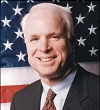What Are the Odds of a Third Straight Republican Term in the White House?

Putting aside how a McCain presidency would govern vis-à-vis Bush, how likely is it that the party of an exiting two-term President could hold onto the power of the White House?
Smart Politics dug back into the history books and examined each of the 11 previous U.S. presidents that had been elected to and served at least two complete terms in office: George Washington, Thomas Jefferson, James Madison, James Monroe, Andrew Jackson, Ulysses S. Grant, Woodrow Wilson, Franklin D. Roosevelt, Dwight D. Eisenhower, Ronald Reagan, and Bill Clinton.
Of the 10 presidents who were affiliated with a political party (George Washington was not), only 3 failed to have coattails for their party’s subsequent nominee:
- Democrat Wilson was succeeded by Republican Warren G. Harding in the 1920 election.
- Republican Eisenhower was followed by Democrat John F. Kennedy in the 1960 election.
- Democrat Bill Clinton gave way to Republican George W. Bush in 2000.
The political party of the remaining 7 presidents was able to keep control of the White House—at least for one more term. However, this has only happened two times since 1876.
- Democrat-Republican Thomas Jefferson was succeeded by Democrat-Republican James Madison in the 1808 election.
- Democrat-Republican James Madison was followed by Democrat-Republican James Monroe in the Election of 1816.
- Democrat-Republican James Monroe was succeeded by Democrat-Republican John Quincy Adams in the Election of 1824 (note: each of the other three principle challengers to Adams were also Democrat-Republicans).
- Democrat Andrew Jackson was followed by Democrat Martin Van Buren after the 1836 election.
- Republican Ulysses S. Grant’s administration gave way to Republican Rutherford B. Hayes after the 1876 election.
- Republican Ronald Reagan was succeeded by Republican George H.W. Bush in the 1988 election.
Democrat Franklin D. Roosevelt was also succeeded by a Democrat, Harry S. Truman (elected in 1948), although that doesn’t cleanly fit with the above examples as Truman had already served out the the remainder of Roosevelt’s presidency after his death in April 1945.
In short, during the past 132 years, an exiting 2-term president’s party has succeeded in retaining power in just one (Reagan to Bush) out of four instances. The time when political parties could control the White House in a dynasty-like fashion appears to be a relic of our political history.
